
Ashley County is a rural South Arkansas county with a culture, economy, and history based on timber and agriculture. Created as Arkansas's 52nd county on November 30, 1848, Ashley County has seven incorporated municipalities, including Hamburg, the county seat and Crossett, the most populous city. The county is also the site of numerous unincorporated communities and ghost towns. The county is named for Chester Ashley, a prominent lawyer in the Arkansas Territory and U.S. senator from the state from 1844 to 1848.
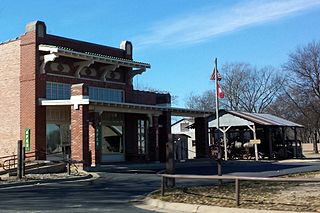
Scott is an unincorporated community and census-designated place (CDP) in Lonoke and Pulaski counties in the central part of the U.S. state of Arkansas. Per the 2020 census, the population was 97. It is part of the Little Rock–North Little Rock–Conway Metropolitan Statistical Area.
A plantation house is the main house of a plantation, often a substantial farmhouse, which often serves as a symbol for the plantation as a whole. Plantation houses in the Southern United States and in other areas are known as quite grand and expensive architectural works today, though most were more utilitarian, working farmhouses.

Magnolia Plantation and Gardens is a historic house with gardens located on the Ashley River at 3550 Ashley River Road west of Ashley, Charleston County, South Carolina. It is one of the oldest plantations in the South, and listed on the National Register of Historic Places. Magnolia Plantation is located near Charleston and directly across the Ashley River from North Charleston. The house and gardens are open daily; an admission fee is charged.
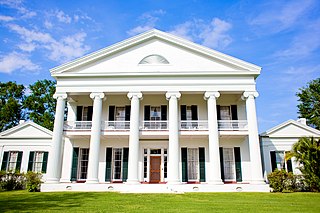
Madewood Plantation House, also known as Madewood, is a former sugarcane plantation house on Bayou Lafourche, near Napoleonville, Louisiana. It is located approximately two miles east of Napoleonville on Louisiana Highway 308. A National Historic Landmark, the 1846 house is architecturally significant as the first major work of Henry Howard, and as one of the finest Greek Revival plantation houses in the American South.
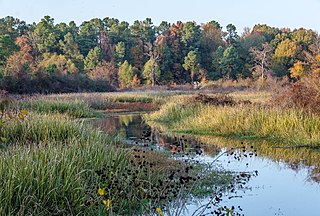
Bayou Bartholomew is the longest bayou in the world, meandering approximately 364 miles (586 km) between the U.S. states of Arkansas and Louisiana.

The Varner–Hogg Plantation State Historic Site is a historical site operated by the Texas Historical Commission. The site was the home of former Governor of Texas James S. Hogg and his family. The site is located outside West Columbia, in Brazoria County.

Millford Plantation is a historic farmstead and plantation house located on SC 261 west of Pinewood, South Carolina. It was sometimes called Manning's Folly, because of its remote location in the High Hills of Santee section of the state and its elaborate details. Designated as a National Historic Landmark, it is regarded as one of the finest examples of Greek Revival residential architecture in the United States. The house has been restored and preserved along with many of its original Duncan Phyfe furnishings.

Rippavilla Plantation, also known as Meadowbrook and Nathaniel Cheairs House, is a former plantation, historic house and museum, located in Spring Hill, Tennessee. This plantation had been worked by enslaved Black people for many years. It is open to visitors as a historic house museum.
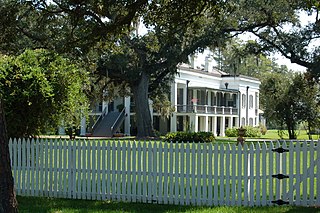
Belle Alliance is an Italianate and Greek Revival plantation house in Assumption Parish, Louisiana, U.S.A. It is the namesake of the unincorporated community of Belle Alliance.
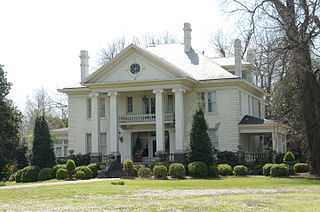
The Dortch Plantation, also known as the William P. Dortch House or the Marlsgate Plantation, is an historic house near Scott, Arkansas. Dortch House is the only plantation home in Arkansas that is fully furnished in the antebellum period style and available for tours and private events.

The Land's End Plantation, also known as James Robert Alexander House, is a historic plantation at 1 Land's End Land in rural southeastern Pulaski County, Arkansas, off Arkansas Highway 161 south of Scott. It is a 5,000-acre (2,000 ha) working plantation, located on the banks of the Arkansas River. The main plantation complex includes a 1925 Tudor Revival house, designed by John Parks Almand, and more than 20 outbuildings. AR 161, which passes close to the main house, is lined by pecan trees planted about 1900 by James Robert Alexander, the plantation owner.

McNutt Rural Historic District is located in Rapides Parish, Louisiana around the intersection of Belgard Bend Rd. and Louisiana Highway 121 that make up the rural community of McNutt, Louisiana. It was added to the National Register of Historic Places on September 15, 1988. McNutt is named from "McNutt Hill," itself named for Isaac McNut], the son-in-law of John Texada, a federal land agent in the area in the early 1800s.

The Stone Plantation, also known as the Young Plantation and the Barton Warren Stone House, is a historic Greek Revival-style plantation house and one surviving outbuilding along the Old Selma Road on the outskirts of Montgomery, Alabama. It had been the site of a plantation complex, and prior to the American Civil War it was known for cotton production worked by enslaved people.

The John B. Russwurm House is an historic house at 238 Ocean Avenue in the Back Cove neighborhood of Portland, Maine. Built about 1810, it was the residence of American abolitionist and Liberian colonist John Brown Russwurm. The house was listed on the National Register of Historic Places in 1983.

Lakeport Plantation is a historic antebellum plantation house located near Lake Village, Arkansas. It was built around 1859 by Lycurgus Johnson with the profits of slave labor. The house was restored between 2003 and 2008 and is now a part of Arkansas State University as a Heritage site museum.
The Wyolah Plantation is a historic Southern plantation in Church Hill, Jefferson County, Mississippi. It is located off the Mississippi Highway 553.

The Taylor Log House and Site is a historic plantation site on Arkanasas Highway 138 in rural Drew County, Arkansas, near the town of Winchester. Included on the plantation site is the best-preserved dog trot house in Arkansas's Lower Delta region. The Taylor Log House, a two-story dog trot built out of cypress logs, was built in 1846 by John Martin Taylor, a Kentucky native who established a plantation on the banks of Bayou Bartholomew. The building was moved, probably in the 1880s. In addition to the house, the site is believed to include archeologically significant remnants of a wide variety of outbuildings. The site was the subject of archeological activities in the 1990s.
Tanglewood Plantation, also known as the Ellison Durant Smith House, is a historic plantation house located at Lynchburg, Lee County, South Carolina. It was built about 1850, and is a two-story, Greek Revival-style clapboard house. It was the seat of a forced-labor farm whose white owners enslaved a large number of African-Americans, including the ancestors of political activist Briahna Joy Gray. The farm's primary crop was cotton.
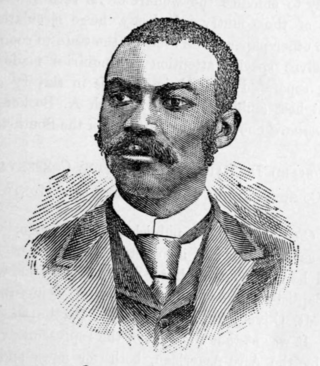
Rev. Joseph Albert Booker (1859–1926), was an American newspaper editor, academic administrator, educator, minister, activist, and Black community leader. He was born into slavery and orphaned at a young age; Booker went on to served as the president of Arkansas Baptist College and editor of the Arkansas state’s Black Baptist newspaper, TheBaptist Vanguard.



















